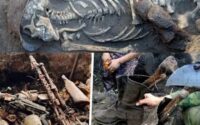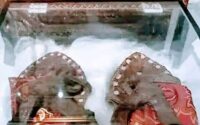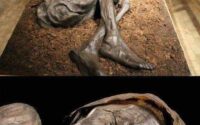The Headless Vikings of Weymouth: A Gruesome Discovery That Defies Explanation .bongbenh
The Headless Vikings of Weymouth: A Gruesome Discovery That Defies Explanation
Introduction
In June 2009, a routine archaeological survey near Weymouth, UK, uncovered a chilling tableau that sent shockwaves through the online community: a mass grave containing the naked, decapitated remains of 51 young Viking warriors, their severed heads neatly stacked to one side. Discovered during preparations for a new road, this gruesome find, dated to between AD 970 and 1025, has been hailed as one of the most disturbing archaeological discoveries in recent British history. The image of 51 skulls piled in a pit, coupled with the mystery of their brutal execution, has ignited a firestorm of curiosity, confusion, and wild speculation across platforms like X. Were these warriors victims of a calculated massacre? Why were their bodies stripped bare? And what happened to the missing three skulls? This article delves into the haunting details of the Ridgeway Hill burial, the science behind it, and the internet’s fevered response, which has transformed this ancient atrocity into a modern enigma.
The Discovery: A Scene of Slaughter
The story began innocently enough, with Oxford Archaeology conducting a pre-construction survey along the route of the Weymouth Relief Road, a £87 million project to improve access for the 2012 Summer Olympics. Expecting to find prehistoric artifacts, archaeologists instead stumbled upon a disused Roman quarry pit on Ridgeway Hill, filled with 54 skeletons—51 with skulls, all male, all beheaded. The bodies were haphazardly thrown into the pit, while the heads were meticulously arranged in a separate pile, suggesting a deliberate act of display. Carbon dating placed the executions between AD 970 and 1025, a turbulent era when Anglo-Saxons clashed with Viking invaders under kings like Aethelred the Unready and Cnut the Great.
The skeletons, mostly of men in their late teens to early 20s, bore marks of extreme violence. Deep cuts to skulls, jaws, and necks indicated multiple sword blows were often needed to sever each head, suggesting a chaotic and brutal execution. One warrior’s hand showed sliced fingers, likely from a desperate attempt to fend off a blade. Curiously, no clothing or artifacts were found, implying the men were stripped naked before burial—a detail that has baffled experts, as even bone buttons should have survived. The site’s prominent location on a hilltop by an ancient road further hinted at a public spectacle, perhaps a warning to other would-be invaders.
Scientific Insights: Who Were These Warriors?
Isotope analysis of teeth from ten of the skeletons provided a breakthrough: these men hailed from Scandinavia, with one likely from north of the Arctic Circle. Their diets, high in protein, matched those of known Scandinavian sites, and their robust physiques suggested warrior training, though some bore signs of chronic infections or physical impairments, like a suppurating leg wound or a deformed femur. One man had filed grooves in his front teeth, a rare Scandinavian practice possibly marking warrior status. These clues painted a picture of a diverse raiding party, gathered from across northern Europe, who met a grim fate far from home.
The timing of the burial aligns with a period of intense Viking raids on England’s south coast, possibly linked to the St. Brice’s Day Massacre of 1002, when King Aethelred ordered the killing of Danes in England. However, unlike the frenzied mob attack in Oxford, the Weymouth executions were methodical, with victims beheaded from the front, a detail some link to the legendary Jomsvikings, elite mercenaries who valued bravery and faced death unflinchingly. Yet, the absence of prior battle wounds and the presence of health issues challenge the image of these men as elite fighters, deepening the mystery.
The Online Frenzy: Curiosity and Conspiracy
When news of the discovery broke, amplified by posts on X like those from @archeohistories and @militaryhistori, the internet erupted. The visceral imagery—51 skulls stacked in a pit, naked bodies tangled in a heap—captivated users, who flooded platforms with hashtags like #HeadlessVikings and #WeymouthMassacre. Comments ranged from awe (“This is straight out of a horror movie!”) to speculation (“Who took the missing skulls?”). The story’s blend of historical violence and unanswered questions made it a perfect catalyst for online debate.
The online community quickly spun a web of theories, each more intriguing than the last:
1. The St. Brice’s Day Connection
Many users linked the burial to the St. Brice’s Day Massacre, citing the timing and the victims’ Scandinavian origins. A thread by @VikingLoreX suggested the men were part of a mercenary group led by Pallig Tokesen, a Danish leader who betrayed Aethelred, making them targets for retribution. However, skeptics on X noted that the methodical executions didn’t match the chaotic mob violence described in historical accounts, leading some to question whether this was a separate incident.
2. The Trophy Head Theory
The missing three skulls sparked intense speculation. Some users, like @HistorySleuth7, proposed they were taken as trophies or displayed on spikes as a gruesome warning, a practice not uncommon in Anglo-Saxon England. Others went further, suggesting the skulls were sent to a Viking leader as proof of victory, or even kept as ritual objects. A particularly wild thread claimed the skulls were hidden in a secret collection, fueling rumors of a modern-day cover-up.
3. The Ritual Sacrifice Hypothesis
A fringe group on X, led by @MysticPast, argued the executions were not mere punishment but a ritual sacrifice to appease Anglo-Saxon gods or assert dominance. They pointed to the nakedness of the bodies and the careful stacking of skulls as evidence of ceremonial intent. While historians dismiss this, citing the lack of ritual artifacts, the theory gained traction among those drawn to the occult, with fan art depicting the pit as a “sacrificial altar” circulating widely.
4. The Alien Conspiracy
Inevitably, the internet’s love for the absurd produced a theory that the Vikings were victims of extraterrestrial intervention. A user named @CosmicRaider88 claimed the missing skulls and lack of clothing suggested an alien experiment, with the bodies “teleported” into the pit. Though ridiculed, the theory inspired memes and mock documentaries, adding a surreal layer to the discourse.
The Community’s Divide: Fascination vs. Skepticism
The online response was a mix of fascination and suspicion. Animal lovers and history buffs shared emotional posts, comparing the warriors’ fate to modern injustices, with one user writing, “Imagine being so far from home, only to end up like this. Heartbreaking.” Others, however, questioned the narrative. A thread by @TruthDiggerX accused Oxford Archaeology of sensationalizing the find to justify the controversial road project, which cut through a protected Area of Outstanding Natural Beauty. The absence of clothing and the missing skulls fueled accusations of a staged discovery, with some users demanding DNA evidence to confirm the Vikings’ identities.
The debate reached a fever pitch when a now-deleted X post claimed an anonymous source at the dig site saw “strange markings” on the skulls, hinting at a hidden ritual. Though unverified, this fueled hashtags like #VikingCoverUp, with users speculating about suppressed archaeological evidence. Meanwhile, exhibitions at the British Museum in 2014 and Dorset’s county museum, where some skeletons are displayed, drew thousands eager to see the “Headless Vikings” for themselves, further amplifying the story’s allure.

Unanswered Questions: What Really Happened?
Despite extensive analysis, key questions remain. Why were the bodies stripped naked? Where are the missing skulls? Were these men elite Jomsvikings, common raiders, or something else entirely? The link to the St. Brice’s Day Massacre is tantalizing but inconclusive, as the executions’ methodical nature suggests a different context. Some researchers propose the men were mercenaries betrayed by their own allies, possibly a rival Viking faction, though no historical record supports this. The pit’s location near a main road and parish boundary points to a public execution, but the lack of artifacts leaves the victims’ full story elusive.
Recent posts on X continue to stoke curiosity, with users like @militaryhistori calling the find “haunting & chilling” and sharing eerie images of the skulls. The National Geographic Channel’s 2010 special, Viking Apocalypse, drew over 7,000 visitors to a Dorchester exhibition, showing the story’s enduring grip on the public imagination. Yet, the more we learn, the more questions arise. As one user, @PastUnraveled, put it, “This isn’t just a grave—it’s a puzzle we may never solve.”
The Broader Implications: A Mirror to Our Times
The Weymouth Vikings’ story resonates because it taps into universal themes: violence, betrayal, and the fragility of life. The online community’s obsession reflects a deeper fascination with history’s dark corners and a distrust of official narratives. In an age where every discovery is dissected on platforms like X, the missing skulls and naked bodies have become a canvas for projecting modern anxieties—about power, truth, and what lies buried. The story’s blend of fact and mystery makes it a perfect storm for the internet, where a millennium-old massacre can spark as much debate as a viral puppy video.
Conclusion
As of July 4, 2025, the Ridgeway Hill burial remains one of archaeology’s most unsettling enigmas. The 51 headless Vikings, their skulls stacked in silent witness, continue to haunt the online community, inspiring everything from scholarly debate to outlandish conspiracies. Whether victims of a royal massacre, a local skirmish, or something stranger, these warriors have found a second life in the digital age, their story retold in hashtags and heated threads. What happened on that Dorset hill a thousand years ago? The truth, like the missing skulls, may never be found—but the mystery ensures the Headless Vikings will live on in our collective imagination.


